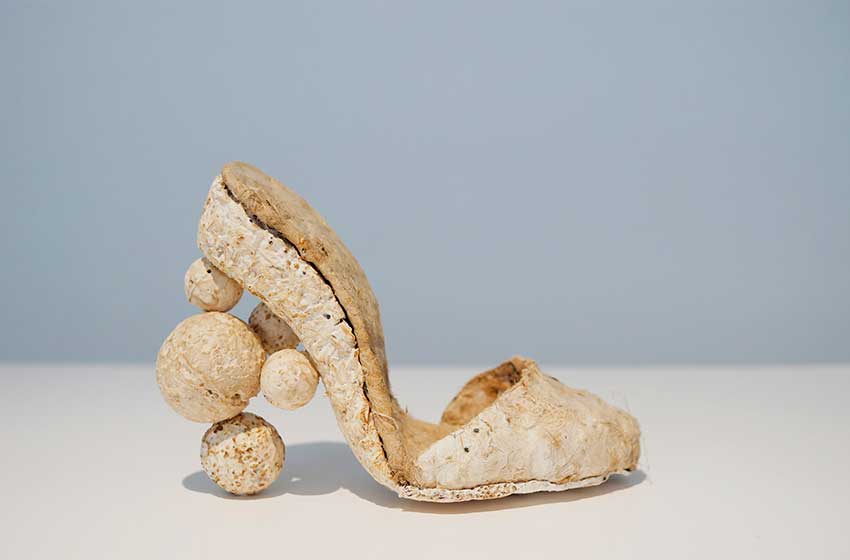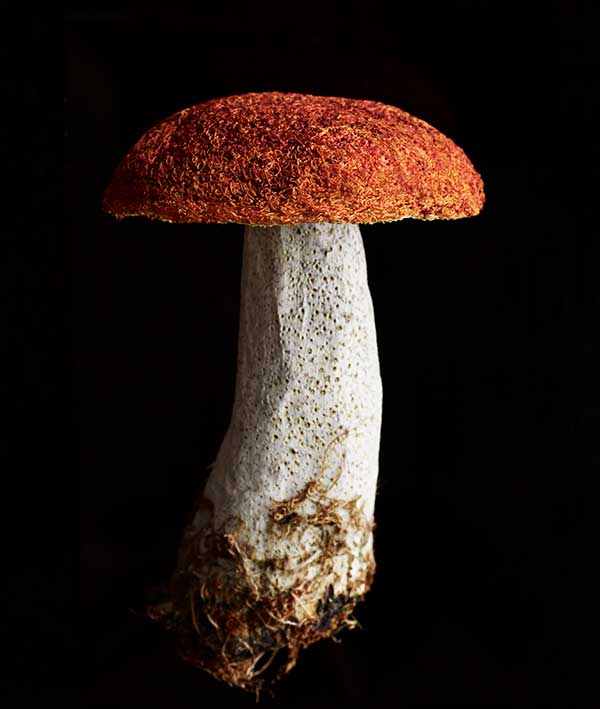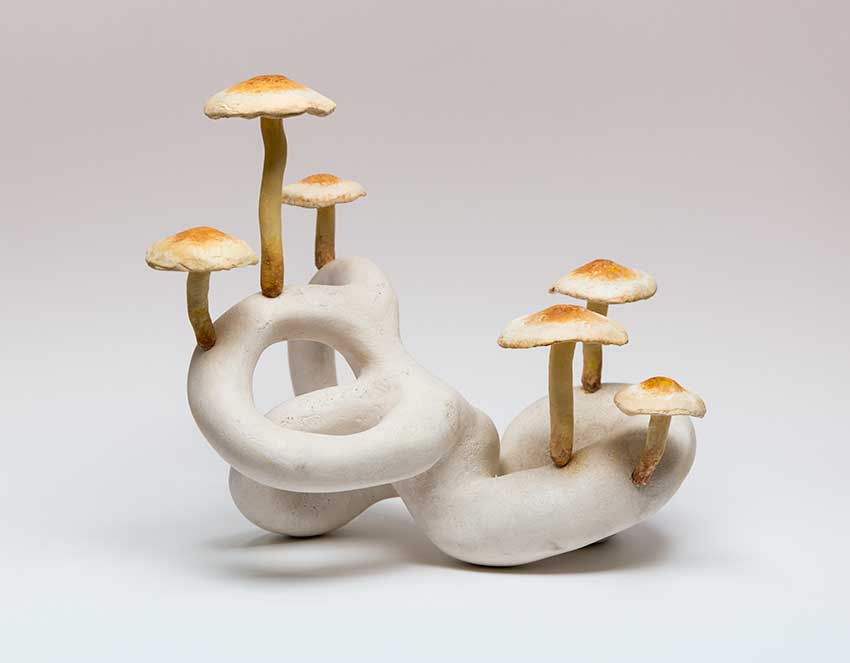Text by Piotr Bockowski

The exhibition Mushrooms: The Art, Design And Future Of Fungi invites us to ever-mutating life of symbiotic hybrids and shows that co-existence of diverse bodies is not a freaky exception in nature but rather a vital necessity facilitated by bio-communication networks of fungi. Inspired by Anna Tsing’s narration about the mushroom at the end of the world [1], the ongoing Somerset House show plays with possibilities of fungal strategies that can lead humans beyond the self-inflicted scenarios of technological disaster.
Tsing offers a narrative of uncontrollable mushroom growth in the “capitalist ruin” of abandoned industrial sites as a promise of solutions to planetary-scale disasters caused by exploitative industrial infrastructures. In her story, fungi become the environmental media of post-industrial, dynamic social networks—the mushrooms at the end of the world signal possibilities for future remediation of environments and communications.
This idea is greatly explored and illustrated by many visual artists at the exhibition, amongst whom Seana Gavin indulges directly in the creation of landscapes of futuristic human inhabitation, where fungi are not only the building materials or energy sources but also prime companions in communication with diverse nonhuman life forms. Gavin introduces us to her visions of future mushroom colonies that merge the ancient wisdom of extinct cultures with science-fiction speculation about fungi-tech applications.
After hundreds of millions of years of evolution, fungal alliances have become part of nature’s body politic. It is time for our species to partake in this ancient mycological wisdom, writes mycologist Paul Stamets [2] who urges us to take an active part in what he calls “Mycotopia” – an environment in which fungi are actively used to enhance or preserve ecosystems. Certainly, the fungal behaviour eludes the imagination of proportionate balance as it spreads by deforming the environment into overly complicated patchy holographic discontinuities. Then, certain technological involvements with the biosphere can be considered advantageous or disadvantageous from the perspective of human survival on the planet.


How can fungi media possibly enhance and preserve human environments? In describing his visionary “mycelial Internet”, Stamets mentions such an advantage for the dynamic functioning of the biosphere processes as enabling greater nutrient flows, the improvement in moisture absorption, the bolstering of disease resistance, erosion reduction, the provision of niches for fauna and flora, and the bequeathing of debris streams for more fungal cycles.
What humans can learn from fungi is their migrating performance of decomposition, which accompanies the spreading their networks. Production of technology and consumption of energy sources has certainly been overdone by the global industrialised societies. As far as the technological culture develops nowadays, the ideas for the ‘making of things’ by humans more often gravitate towards using fungal bodies.
Several Internet forums, such as Fungal Materials & Biofabrication [3], group a rapidly growing number of people who exchange their practical solutions in applying fungi to self-made technologies. Accentuating their awareness of environmental issues, they offer a possibility of a movement positioning themselves firmly against the destructive impact of global industries. Fungal Materials & Biofabrication forum witnesses a grassroots online community of mostly individual makers who replace the industrial solutions for mass production of things with DIY biotechnologies mainly based on the idea of growing mycelia in certain shapes and then killing them by drying them out.

Those dry fungal corpses seem to be able to became a self-made substitute for virtually anything: from obvious by now clothes (threads, fungoid “leather”, fabrics) and furniture, dishes, packaging (most notably many substitutes for plastic) or architectural materials (bricks, rods, structural tubes, piping, building insulation, roofs), to more seemingly unusual applications such as canoes, beehives, water filters, electricity conductors, headphones, acoustic panels, immune systems for plant farming, infrastructures for cleaning toxins or even radioactive pollution (in Chernobyl).
Presented during last year’s Fungi Fest [4] in London Eastend, Chinese acupuncture uses Reishi mushrooms for medical purposes, asserting that they communicate with certain fungi growing inside human bodies that essentially regulate their immune systems. Reishi is an example of another supportive for the human immune system fungus, which kills many disadvantageous microbial or fungal infections of the human body. Reishi’s influence is an example of the decomposition of parasitic entities within the human body, similar to other mushrooms, which grow on plants and guard them off of various parasites.
Fungal decomposition not only breaks down the corpses of complex plant and animal organisms but also supports the integrity of alive organisms by decomposing malicious bodies and neutralising toxic elements within them. Considering the special qualities of some fungi as radiation shields, at the beginning of 2020, NASA published spectacular revelations about their research into growing outer space habitats on the Moon, Mars and beyond [5]. NASA considers the possibility of building living complexes from fungi for humans outside of our planet but also looks into applying the same solutions to designing future cities on Earth.
This ambitious fungi technology project, together with sheer multitude of individual practices of ecologically clean and completely biodegradable making of things, promise an escape from earthly environmental problems caused by reckless industrial production and global consumerism.






